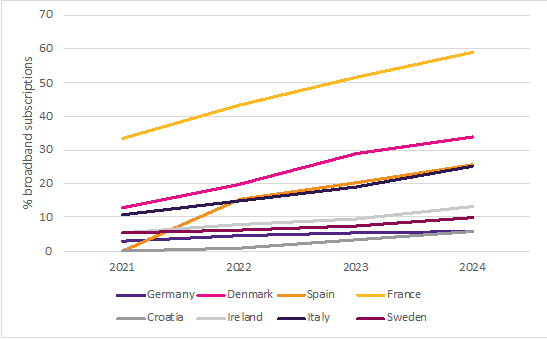Today, Arcep is publishing a study carried out by a consulting firm, Plum, whose remit was to provide an assessment of the French regulatory framework that has been in force since 2009, known as the symmetric framework governing the deployment of optical fibre, or FttH (Fibre-to-the-Home), networks in France.
The study first provides a summary of the symmetric regulatory framework. It then delivers an analysis of its results. The assessment is a positive one with respect to the key objectives being pursued at EU level, in terms of FttH deployment across France, investment efficiency, competition between operators, as well as consumer retail prices. The Plum study then compares the French model with those applied in other EU Member States, and maps out the potential effects of regulatory changes through multiple scenarios.
In 15 years, rapid nationwide coverage and significant take-up rates for fibre in France place it at the top of EU Digital Decade rankings
In less than 15 years, optical fibre (FttH) coverage in France reached more than 90%, compared to the European Union average of 69% at the end of 2024. This coverage was achieved concurrently in urban and rural areas, with private sector investment of close to 35 billion euros, representing at least 73% of total spending on FttH rollouts in France. In terms of national coverage levels for networks providing speeds above 1 Gb/s, France is among Europe’s leaders, just behind Spain and Denmark, and tied with Sweden.
When it comes to subscriptions to plans providing speeds above 1 Gbit/s, France is far ahead of its European peers, with a consumer take-up rate that is three times the European Union average.

Virtually every premises benefits from strong competition: on average, 98% of premises covered by FttH have a choice of between at least three ISPs.
The retail prices for FttH plans are among the lowest in Europe.
Arcep’s symmetric regulation, ensuring the efficiency of past and future deployments
The study analyses different scenarios to examine the extent to which the results achieved by the regulatory framework in France might be affected by regulatory changes in the short and long term: a partial or complete removal of symmetric regulation, or removal of the obligation for the incumbent to provide access to its civil engineering infrastructure to competitors, which is a cornerstone of the current regulatory framework governing fibre network deployment. The analysis of the different scenarios concludes that these changes would have negative effects (decreased coverage, increased retail prices).
This study will contribute to the Authority’s ongoing work ahead of the notification of its own assessment of symmetric regulation to the European Commission in the coming months. To this end, a public consultation on a draft assessment will be launched in the coming days.
The particular features of the symmetric regulatory framework adopted in France: a framework that applies equally to every operator deploying a fibre network
The regulatory framework governing FttH in France is referred to as “symmetric” as it requires any operator deploying an optical fibre local loop to grant all reasonable requests for access from third-party operators to access that network’s lines. Thanks to this guaranteed access to a passive infrastructure where at least one operator has deployed fibre, the framework encourages extending coverage rather than overbuild, thereby fostering efficient investments in networks in the long run.
